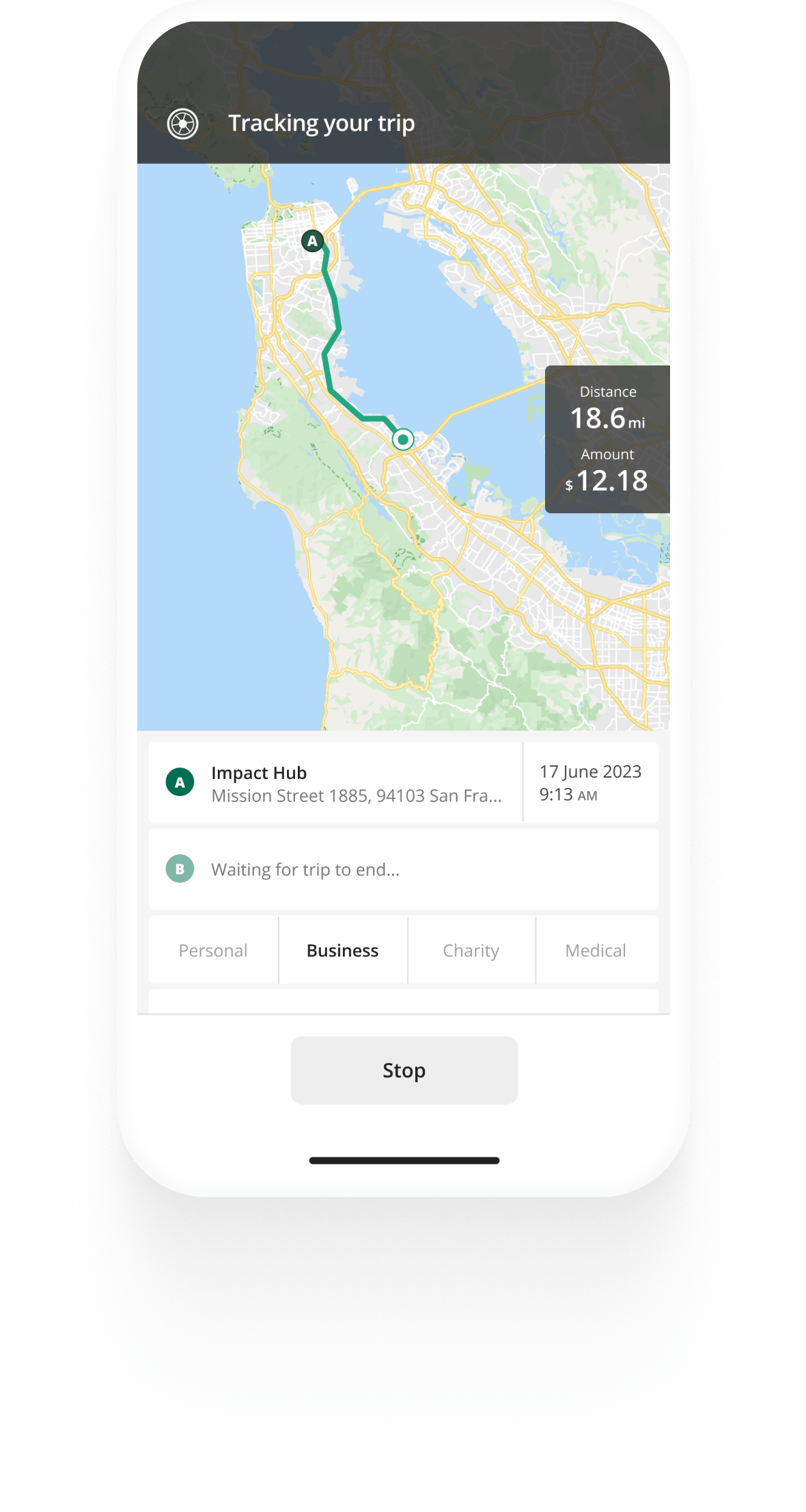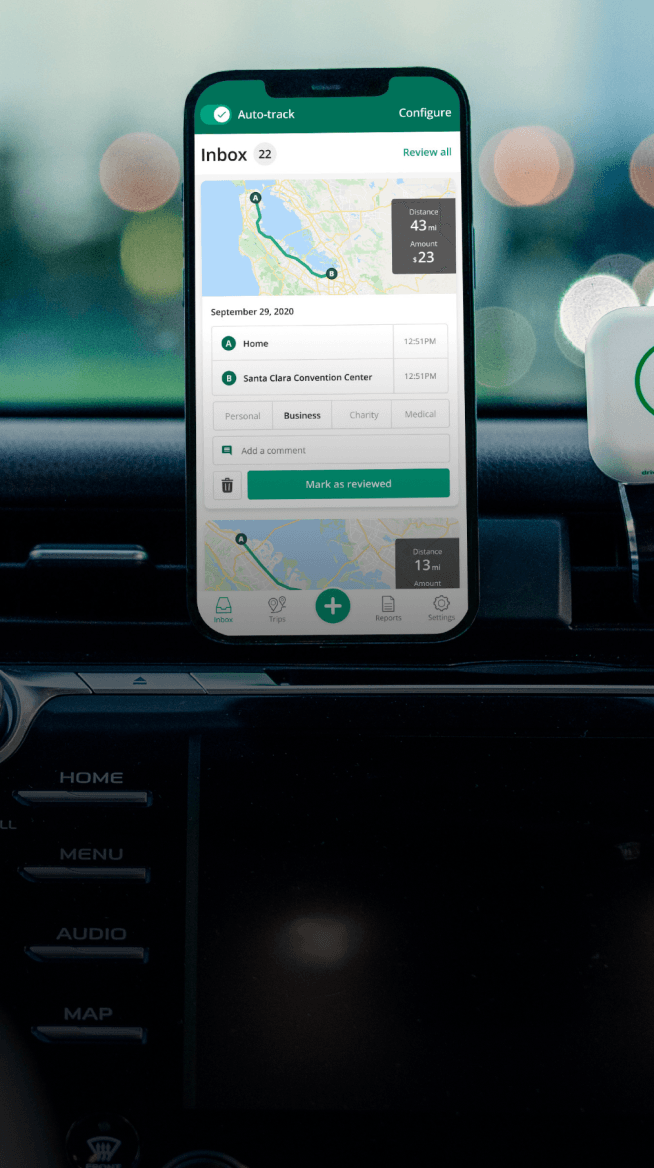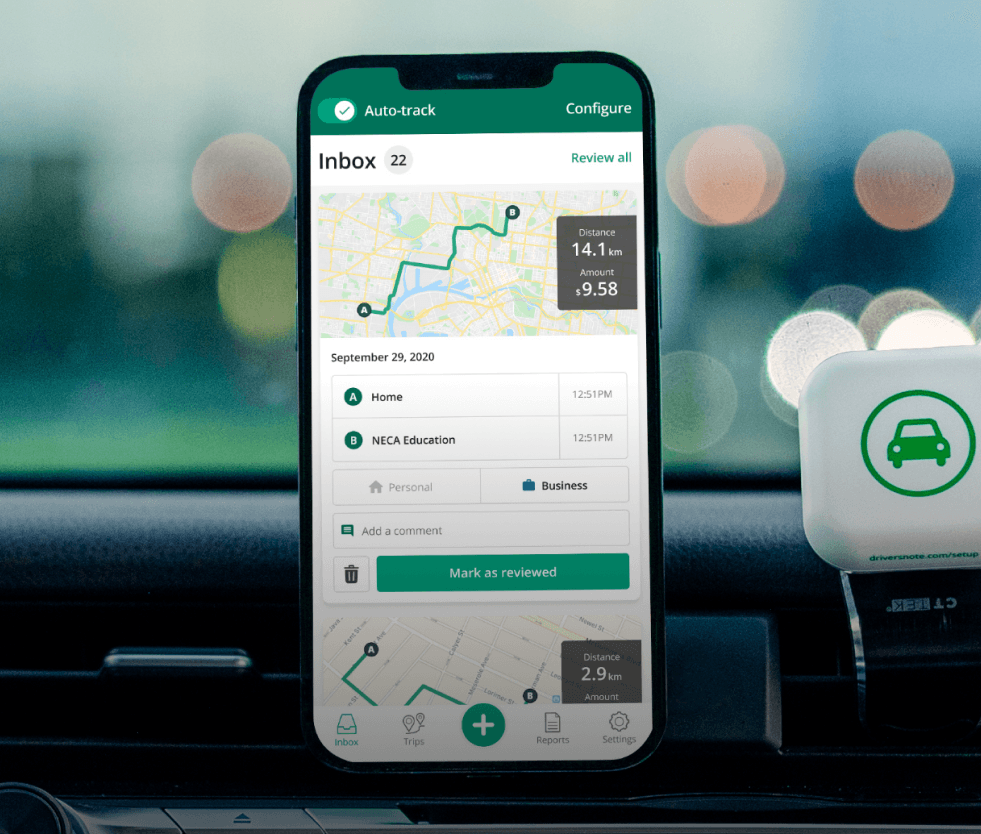Track mileage automatically
Get startedYour Guide to IRS Mileage Reimbursement
In this article
- What is mileage reimbursement?
- What is the federal mileage reimbursement rate?
- What travel qualifies for mileage reimbursement?
- Is mileage reimbursement taxed?
- IRS mileage reimbursement rules
- Keeping compliant records for your IRS mileage reimbursement
- Curious to calculate your mileage reimbursement?
- FAQ
- What is mileage reimbursement?
- What is the federal mileage reimbursement rate?
- What travel qualifies for mileage reimbursement?
- Is mileage reimbursement taxed?
- IRS mileage reimbursement rules
- Keeping compliant records for your IRS mileage reimbursement
- Curious to calculate your mileage reimbursement?
- FAQ
Need a straightforward guide to mileage reimbursement in 2025? You’re in the right place!
This guide covers the latest rules, rates, and what’s considered business mileage. Whether you’re using your personal vehicle for work and need reimbursement from your employer, or you’re self-employed and wish to claim a tax deduction, we’ll break it down so you know exactly what to expect.
What is mileage reimbursement?
Mileage reimbursement is the compensation you may receive when you use your personal vehicle for business purposes. The IRS mileage reimbursement applies to cars, vans, pickups, and panel trucks and is usually calculated per mile. The reimbursement covers costs for using your vehicle for business, including fuel, maintenance, repairs, insurance, registration, and depreciation, but excludes personal or commuting mileage.
If you’re an employee, you can receive mileage reimbursement from your employer. Self-employed and independent contractors can deduct business mileage expenses from their taxes, and employers who provide mileage reimbursements to employees can account for these as business expenses.


Mileage tracking made easy
Trusted by millions of drivers
Automate your logbook Automate your logbook

Automatic mileage tracking and IRS-compliant reporting.
Get started for free Get started for freeWhat is the federal mileage reimbursement rate?
The 2025 mileage reimbursement rate for business-related driving is 70 cents per mile. The medical and moving mileage rate is 21 cents per mile, and the charity mileage rate is 14 cents per mile.
The 2024 mileage reimbursement rate for business miles is 67 cents per mile, 21 cents for medical and moving miles, and 14 cents for miles in the service of charitable organizations.
See the updated 2025 IRS mileage rates and the previous IRS mileage rates for 2024.
What travel qualifies for mileage reimbursement?
You can only receive mileage reimbursement for miles you've traveled for business purposes. The IRS defines business mileage as the mileage you drive between two places of work, permanent or temporary.
The types of trips that are considered business-related are:
- Traveling between your main job and a temporary work location
- Traveling directly from your main job to a second job
- Traveling between a temporary work location and your second job
- Getting from your home to a temporary workplace if your regular job is at another location
Trips that ARE NOT considered business-related are:
- Traveling between your home and your main job
- Traveling between your home and your second job
You may wonder what the difference is between a regular job location, a temporary work location, and a second job location.
In brief, a regular job location is the main place of business of the company you have or the company that employs you. A temporary work location is one where you are assigned to work for a year or less (away from your regular job location). A second job location is another place (with the same or different employer) where you work on the same days as your main job.
Can it be reimbursed?
To clarify which mileage can be reimbursed, here are a few examples of business travel scenarios:
- You drive from your main office to a secondary office of your firm.
- You visit clients and drive from your office to their workplace.
- You’re running work-related errands from your office to a supply store, the post office, or a governmental entity.
- When you need to travel from your home to a secondary office of your employer if you have been assigned to work there for a year or less.
Slightly different rules for self-employed
As a self-employed individual or an independent contractor where your home is your place of work, the rules slightly differ. If your home office qualifies as your main place of business, you can deduct the transportation costs between your home and another work location for the same business.
Is mileage reimbursement taxed?
Mileage reimbursement that complies with IRS rules is not considered a benefit and isn’t taxed. However, if you’re reimbursed at a higher rate than the standard IRS rates or by another type of reimbursement, such as lump sums, the sum exceeding the rate per mile reimbursement will be considered a benefit and taxed as a part of your income.
Read more about mileage reimbursement as a taxable income.
IRS mileage reimbursement rules
For employees
If you drive your personal vehicle for business purposes, you will be eligible for mileage reimbursement from your employer. While no federal laws require employers to reimburse employee mileage, state laws sometimes require employees to provide mileage reimbursements. This is the case in California, Massachusetts, and Illinois.
Your employer may reimburse you at the standard IRS mileage rate, at FAVR (fixed and variable rate), or provide you with a fixed monthly mileage allowance.
The standard mileage rate covers all fixed and variable costs of using your vehicle for business driving. It’s typically paid once you have provided a log of your business mileage.
FAVR consists of two separate payments, one for fixed and another for variable costs.
A mileage allowance is typically paid upfront monthly, so you have cash on hand for your month’s business mileage expenses.
Keep in mind that all types of reimbursement payments, no matter the chosen method, must be lower per mile than the IRS mileage rate per mile. Any reimbursement program that doesn’t meet the IRS conditions will be considered a benefit and taxed as such.
Provide your employer with consistent records of your mileage
To be reimbursed for your business driving, you must provide your employer with consistent mileage records.
They should include information for every business trip, including the date, destination, purpose, and total mileage driven. Some employers might require more than this, so always check with your employer before you start keeping a mileage log.
Note that according to the Tax Cuts and Jobs Act, you won’t be able to claim mileage as a tax deduction even if your employer doesn’t reimburse you.
For self-employed individuals
As a self-employed taxpayer, you can deduct mileage accrued for business purposes. If you use your vehicle solely for business, you can deduct all the expenses related to owning and operating it. If you use your vehicle for personal and business travel, you can only deduct the costs associated with its business use.
Two methods of calculating your mileage claim
There are two methods of calculating your mileage claim for tax deduction purposes:
- The standard mileage rate method
- The actual expenses method.
The more straightforward method for claiming mileage is the standard mileage rate method. With it, you use the official business rate per mile the IRS sets to claim business miles. A mileage log is the only documentation you need to keep throughout the year.
The actual expenses method lets you deduct the actual costs associated with owning and operating your vehicle for business purposes over the year. This approach is a bit more detailed, so you'll need to gather all your receipts for vehicle-related expenses.
Claim your deductions every year
You can claim a mileage deduction every year on your tax return. Just remember to have documentation of your business miles and can substantiate your claim. See our dedicated article on self-employed mileage deductions to learn more about the methods and how to select the right one for you.
For employers
As an employer, you aren’t required to provide mileage reimbursement to your employees, but more often than not, it will be expected of you to do so, and it often makes you a more competitive employer.
The rate-per-mile method of mileage reimbursement
While there are several methods by which you can reimburse employees for their work-related mileage, the simplest is to use the standard IRS mileage reimbursement rate per mile.
Every month, employees submit their mileage logs to verify their business travel and are reimbursed 70 cents for every mile driven (the official rate for 2025).
It's important to note that this reimbursement should not be counted as part of employees' income since it isn't classified as a benefit. You can then expense the mileage reimbursement payments from your company's profits. It’s worth noting that while the IRS publishes an official mileage rate every year, you’re not obliged to use it when you reimburse your employees. You can reimburse them at a higher or lower rate than the official one.
Other methods for mileage reimbursement
In addition to the rate-per-mile method, you can consider a few other methods for reclaiming employees' miles, such as providing car allowances or fixed and variable rates. Our dedicated mileage reimbursement for employers guide explains each method's pros and cons.
If you have multiple employees who submit mileage logs for reimbursement, you might want to consider a mileage log solution for teams to ease the documentation and approval process.
Keeping compliant records for your IRS mileage reimbursement
IRS mileage reimbursement rules require that you keep accurate, compliant mileage records. Keeping accurate records means recording your mileage at or near the time of each trip you take.
In practice, this means keeping a mileage log with your trips that contain:
- The total mileage of each trip
- The time
- Your destination
- The purpose of each trip
- The total mileage for the year
Keep in mind that if you use your vehicle for both business and personal driving, you should keep track of both to figure out the percentage of business use for which you can claim mileage reimbursement. Learn more about keeping compliant mileage records.
Curious to calculate your mileage reimbursement?
According to IRS mileage reimbursement rules, you can only claim mileage for the business use of your vehicle.
But what is business use? Let's go through a quick example:
You've driven a total of 300 miles in 2024. You have ten personal trips that total 200 miles and three business trips that amount to 100 business miles.
Calculating your total mileage reimbursement based on the IRS mileage reimbursement rate is simple: multiply the business mileage you’ve driven by the current IRS mileage rate.
100 business miles x 67 cents = $67 in mileage reimbursement.
Use the calculator below to calculate your mileage reimbursement quickly.
If you need to figure out the business use portion of your vehicle for the actual expenses method, divide your business miles by the total mileage. In our example, your business mileage is 33% of the total miles you’ve driven.
The equation is simple: 100 business miles / 300 total miles = 0.33 = 33%.
Then, you can deduct 33% of all vehicle expenses.
FAQ

Tired of logging mileage by hand?
Effortless. IRS-compliant. Liberating.
IRS Mileage Guide
- For Self-Employed
- For Employees
- For Employers
- Mileage Log Requirements
- How To Claim Your Mileage On Taxes In 5 steps
- Calculate Your Reimbursement
- Is Reimbursement Taxed?
- Current Mileage Rates
- Historical IRS Mileage Rates
- IRS Medical and Charitable Mileage
- California Mileage Reimbursement
- How is the IRS Mileage Rate Calculated